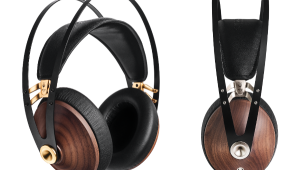Review: AudioTechnica ATH-AD900X Page 2
Measurements
To measure the performance of the ATH-AD900X, I used a G.R.A.S. 43AG ear/cheek simulator, a Clio FW audio analyzer, a laptop computer running TrueRTA software with an M-Audio MobilePre USB audio interface, and a Musical Fidelity V-Can headphone amplifier. Measurements were calibrated for ear reference point (ERP), roughly the point in space where your palm intersects with the axis of your ear canal when you press your hand against your ear. I experimented with the position of the earpads by moving them around slightly on the ear/cheek simulator, and settled on the placement that gave the best bass response and the most characteristic result overall.
The ATH-AD900X ‘s frequency response is pretty typical for an open-back headphone. Not much bass, but a lot of energy in the highs at 4 kHz and above. Adding 70 ohms output impedance to the V-Can’s 5-ohm output impedance to simulate the effects of using a typical low-quality headphone amp has little effect, just + dB at 140 Hz.
Total harmonic distortion (THD) at 100 dBA is extremely low, under 1% at frequencies above 45 Hz and rising to just 2.5% at 20 Hz. Isolation is practically non-existent, as expected for an open-back headphone.
As an experiment—just something I’ve been wanting to do for a while, and something a few readers have requested—I’ve added a spectral decay plot to my measurements for the ATH-AD900X. This lets you see resonances in the headphone. An ideal plot would show a thin colored line at the top and nothing but black below. As you can see in this one, the blue areas suggest some fairly strong resonances between 1.5 and 3 kHz. Although I’ve plotted only a few headphones like this so far, this looks like an unusually large amount of resonance. The resonance you see in the bass is normal, something most headphones I’ve measured this way seem to have.
Measured impedance averages about 38 ohms. Average sensitivity with a 1 mW signal at the 38 ohms rated impedance is 106.2 dB from 300 Hz to 6 kHz.
Bottom line
I can’t promise you’ll love the ATH-AD900X, but I sure do. Unlike a lot of headphones—maybe most headphones—I never get tired of listening to it, and I never get uncomfortable wearing it. Its predecessor, the ATH-AD900, was readily available at street prices of $200 or even less. If the ATH-AD900X follows suit, it’ll be one of the world’s best bargains in an audiophile headphone.



























































